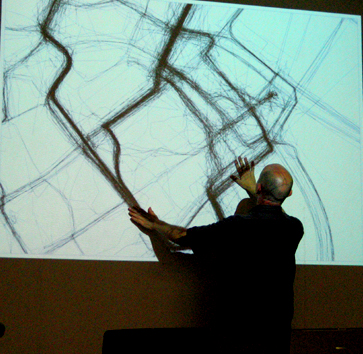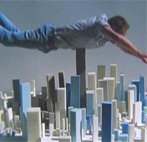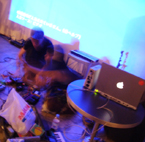The moon
The Moon is a special project which brings together the different cultural perspectives of UK and Japan, but also the different cultures of tradition and the contemporary, of religion and of art, of nature and the man-made. It is a project which forges many collaborations, many new ties and many new perspectives. Three Japanese artists and three British artists came together to respond to a very particular context, that of a Zen temple garden in Kyoto. The historic site is famed for ‘tsukimi’ moon viewing, and attracts thousands of visitors each week to experience its special aura.

In both Japan and the UK there are very strong connotations linked to the moon and many mythologies which surround it.
In Japanese folklore there are tales such as‘Taketori Monogatari’ in which a baby found in a bamboo stalk is revealed to be a princess of the moon. There are humorous tales of the craters of the moon being created by rabbits pounding mochi. Further more the moon is of course highly symbolic of reflection and enlightenment in Zen Buddhism.
In the UK there are also many contradictory associations with the moon, there is the wise old man in the moon (whereas in Japan we see a rabbit) yet also the connotation of 'lunacy', the moon having a maddening affect, and of course linked often in horror tales with beastly transformations and marking a time when crossings occur between the real world and that of phantoms. The moon also at the same time has a natural association with femininity a symbol of the female cycle and ruled by a goddess in European mythology.
The project dealt with notions of site-specifity and in this case the site chosen had a very strong character, with a deep cultural, historical and religious context. As artist Chris Wainwright commented it appears to be near impossible to place a foreign body within a space that is already so rich within itself and already nearing perfection. It was most challenging to bring contemporary art into the institution of the temple, both have their set of regulations which can conflict in some ways with each other. The artists made a detailed investigation of the site, involving much research and made very personal responses which reflected the depth of their engagement with the history and context of the garden and its relation to the moon, with many different approaches to this. The works created a tension between reflecting the environment, harmonizing with it and with interrupting and disturbing it, a balance very hard to find.
Morishita taisuke
 |
Morishita Taisuke employs ‘shakkei’ in his installation, the art of borrowing the landscape or mirroring it. His pillar of light echoes the rising pagoda in the distance and the light of the moon which rises above it, yet its bright luminous colour and strong form also collide with these elements. |
chiba kentaro
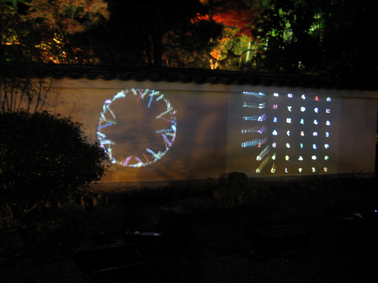 |
Chiba Kentaro presents a highly literary work based on an old form of poetry which creates panagrams from the 47 phonetics of the Japanese language. |
Kamma keiko
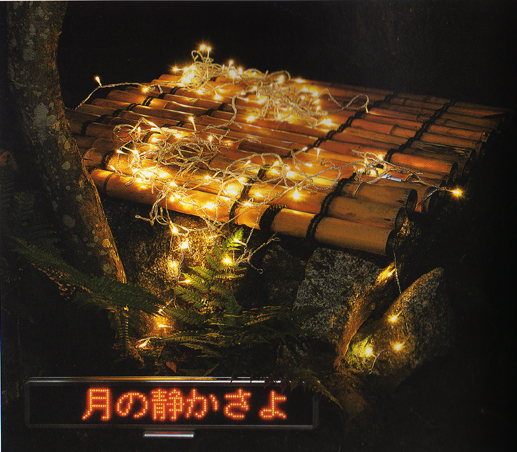 |
Kamma Keiko uses light, sound and language in her contemplation of the moon. Mixing Haiku and other poetry referencing the moon, with instrumental and field recordings,
|
chris wainwright
 |
Chris Wainwright’s work takes the man in the moon and the man on the moon and converges them. An image taken from a medieval stained glass panel in a church in England and the infamous image of the Apollo moon landing of 1969 become one and the same in this interventricular image. Science and religion are juxtaposed, but the truth of either becomes equally questionable.
|
Anne Lydiat
 |
Anne Lydiat pursues the moon’s associations with the female in her work which presents a female moon moth within a bell jar. Moths use moonlight for navigation and are therefore attracted by any source of white light The moth itself is a symbol of feminity and the moon the rhythms of the female. However here the moth is trapped and frozen in death in the artificial moonlight. |
tina keane
 |
Tina Keane presents ‘Blue Moon’, the phrase ‘once in a blue moon’ refers to the rarity of an event, a blue moon being the phenomenon where there is a full moon twice in the same month, occurring approximately every 2.7 years. In reference to this Keane has taken the famous Hollywood song Prayer/Blue Moon written by Rodgers & Hart which was changed several times to meet the demands of the production company, and repeatedly cut from the films it was commissioned for.
|
